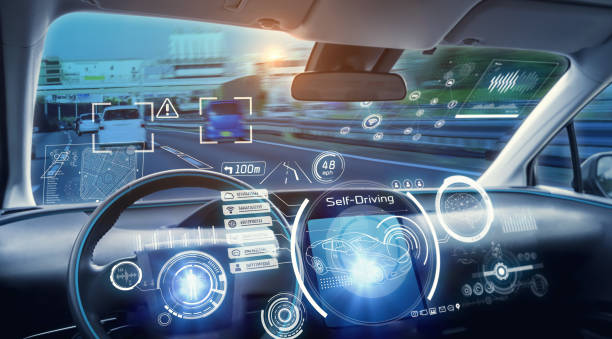Holographic Heads-Up Displays: The Future of Car Cockpits
The automotive world stands on the brink of a visual revolution. Imagine driving down a bustling city street, your eyes never leaving the road, yet all the information you need hovers right before you in stunning 3D clarity. This isn't science fiction; it's the promise of holographic heads-up displays (HUDs). As we accelerate into a new era of automotive technology, these futuristic interfaces are set to transform our driving experience, merging the digital and physical worlds like never before. Let's dive into the cutting-edge world of holographic HUDs and explore how they're reshaping the car cockpits of tomorrow.

However, traditional HUDs have limitations. They typically display flat, 2D images with a limited field of view. Enter holographic technology, which promises to overcome these constraints and usher in a new age of immersive, three-dimensional displays that seamlessly blend with the driver’s view of the road ahead.
How Holographic HUDs Work
Holographic HUDs utilize advanced optics and light manipulation techniques to create the illusion of 3D images floating in space. Unlike conventional HUDs that project onto a flat surface, holographic systems use a combination of lasers, mirrors, and specially designed windshield glass to generate true volumetric displays.
The core technology involves splitting laser beams into different colors and projecting them onto a series of micro-mirrors that vibrate at high frequencies. These mirrors then reflect the light onto the windshield, which is coated with a special film that acts as a diffraction grating. This process creates a virtual image that appears to float in front of the vehicle, with depth and dimensionality that traditional displays can’t match.
Enhancing Safety and Driver Awareness
One of the primary advantages of holographic HUDs is their potential to dramatically improve driver safety. By presenting information in a more natural, three-dimensional format, these systems reduce the cognitive load on drivers. Important data such as speed, navigation instructions, and collision warnings can be displayed at different perceived distances, allowing drivers to process information more intuitively.
For instance, a holographic HUD could project a virtual arrow that appears to float above the actual road, guiding the driver through complex intersections. Or it could display a 3D representation of nearby vehicles, making it easier to judge distances and potential hazards. This enhanced spatial awareness could be particularly beneficial in challenging driving conditions like heavy fog or darkness.
Augmented Reality Integration
The true power of holographic HUDs lies in their ability to seamlessly integrate augmented reality (AR) elements into the driving experience. By overlaying digital information onto the real world, these systems can provide context-aware assistance that goes far beyond traditional navigation systems.
Imagine approaching a restaurant and seeing holographic reviews floating above it, or receiving real-time traffic updates that appear to hover over the affected roads. AR-enabled holographic HUDs could highlight potential hazards, such as pedestrians or animals, by outlining them with glowing markers that grab the driver’s attention without being overly distracting.
Challenges and Technological Hurdles
While the potential of holographic HUDs is immense, several challenges must be overcome before they become mainstream. One of the primary hurdles is achieving sufficient brightness and contrast to ensure the holograms are visible in all lighting conditions, from bright sunlight to pitch darkness.
Another significant challenge is minimizing latency. For AR applications to be effective, the holographic elements must align perfectly with the real world, with no noticeable delay. This requires extremely fast processing and precise motion tracking to account for the vehicle’s movement and the driver’s head position.
Additionally, there are concerns about information overload. Designers must carefully balance the amount and type of information displayed to avoid overwhelming or distracting the driver. Creating intuitive interfaces that enhance rather than hinder the driving experience is crucial for widespread adoption.
The Road Ahead for Holographic HUDs
As automotive manufacturers and tech companies continue to invest in this technology, we can expect rapid advancements in the coming years. Some experts predict that by 2030, holographic HUDs could be standard equipment in many new vehicles, particularly in the luxury and high-performance segments.
The integration of artificial intelligence and machine learning will likely play a crucial role in the evolution of these systems. AI-powered holographic HUDs could adapt to individual drivers’ preferences and habits, presenting personalized information and alerts based on learned patterns and behaviors.
Furthermore, as vehicles become increasingly connected, holographic HUDs could serve as the primary interface for a wide range of services, from entertainment and communication to vehicle diagnostics and maintenance alerts.
Conclusion: A New Dimension in Driving
Holographic heads-up displays represent a quantum leap in automotive interface design. By merging the digital and physical worlds in unprecedented ways, they promise to enhance safety, improve driver awareness, and transform the entire driving experience. As this technology continues to mature, we can look forward to a future where our windshields become windows into a world of information, seamlessly integrated with the road ahead. The holographic revolution is set to redefine what it means to be behind the wheel, ushering in an era where the line between reality and digital enhancement blurs, creating a truly immersive and intelligent driving environment.





